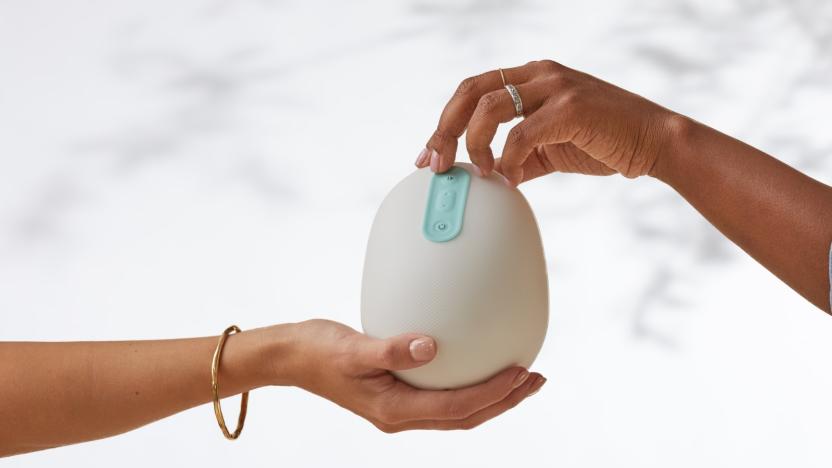breastfeeding
Latest

Willow's latest smart breast pump promises a more comfortable design
It's been three years since a smart breast pump stole the show at CES 2017. Since then, Willow has been doing what any tech company would do after it has its first hit: iterate, iterate, iterate. Over the past few years, Willow has made its wearable breast pump easier to operate, and it's also added an optional reusable container for moms who don't like the idea of trashing disposable milk bags. This year, at CES 2020, Willow is unveiling its third-generation pump (and allowing its space to double as a breastfeeding room for nursing mothers attending the show). Though the device looks similar to last year's model, the company is touting some under-the-hood improvements that promise better comfort and a higher milk yield. Specifically, the company claims that moms can expect around 20 percent more milk, on average, per session. (That's based on focus groups with "experienced" users who pumped at least 20 times in testing.) As for comfort, the company has added new suction levels, a slower, gentler pumping rhythm, a "sensitivity" setting and a feature that adjusts the suction settings based on the user's preferences. Of course, the Willow wouldn't be the Willow without some signature hardware features. Like both of its predecessors, it takes the form of two wearable, battery-operated cups -- one of the device's chief selling points has been that moms don't need to sit tethered to a wall outlet while breastfeeding. The pump sends milk straight into a receptacle, whether that be the standard disposable bag or the reusable container, sold separately. The device is also designed to be quiet -- an area where Willow makes progress with each successive generation. Lastly, Willow's shtick is that it promises a design so leakproof you can even do yoga poses while wearing it, though you'll have to take someone else's word for it -- our staff has yet to test that claim. On the software side, the companion app is being updated with personalized pumping tips, onboarding help for new users and what Willow claims is a faster, easier pairing process. As ever, the app tracks volume over time, so women can see how much milk they've produced in various pumping sessions. Willow Generation 3 will be available sometime this spring for $499.99, the same price at which the last-gen model launched. Like its predecessor, it will come with two pumps and 24 milk bags. It will be available in three sizes: a new 21mm, along with the current 24mm and 27mm sizes. The second-generation model will still be sold, also for $499.99 but with a container included. That, too, will be available in the smaller 21mm size, though don't expect the older device to work with the new app; those software features are reserved for Generation 3.

Even breastfeeding is getting quantified, thanks to Momsense
The health benefits of breastfeeding are well-known, yet for various reasons, many new mothers quit after a few months. Maybe they don't have the time, they find it uncomfortable or they believe that the baby isn't getting enough milk. A new product called Momsense is taking aim at this last problem with a product and app that can keep track of how much a baby is actually drinking, hopefully putting a mom's worries at ease.

MIT Media Labs' next hackathon will make breast pumps suck less
MIT's Media Lab plans to fix the breastpump. In fact, its fall 2014 hackthon is dedicated to this very aim. Breast pumps are time-consuming, noisy and often painful -- and as the organizers put it (rather TechCrunch-ly): "this is a space that is ripe for further innovation." There's already several problems set to be tackled: the hardened cones that cup over the breasts, the litany of parts, tubes and bottles, as well as a lack of metrics: existing pumps don't offer any information on how much milk is collected, or when. Over at Quartz, they've added their own ideas for the to-do list, including ensuring a closed-system that won't be ruined by water, milk and the inevitable mold, as well as a pumping system that's generally more discrete. It's in fact the second breast pump hackathon, but this sequel will encompass 60-80 engineers, designers and breastfeeding experts -- registration is open.

Facebook relaxes its policy on breastfeeding photos
Breastfeeding in public tends to bring out some strong opinions: For every person who believes there's nothing raunchy about feeding one's child, there's someone who thinks women should keep it in their blouses unless behind closed doors. And while the debate rages on, Facebook, at least, has taken a stand: The company has quietly adopted a more lax approach to breastfeeding photos, wherein someone can post such a picture even if a breast is fully exposed (and that includes the one the baby isn't nursing from). Mastectomy pictures are allowed too, though other images of topless women will still be removed.


